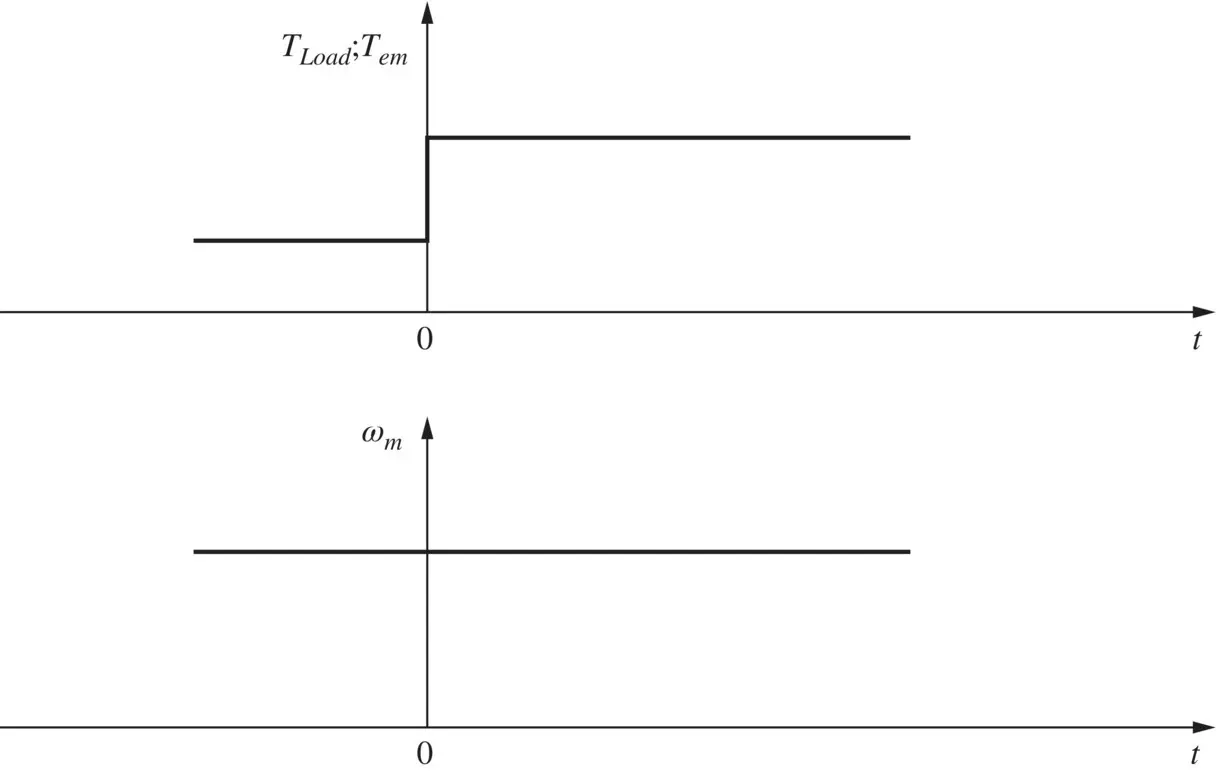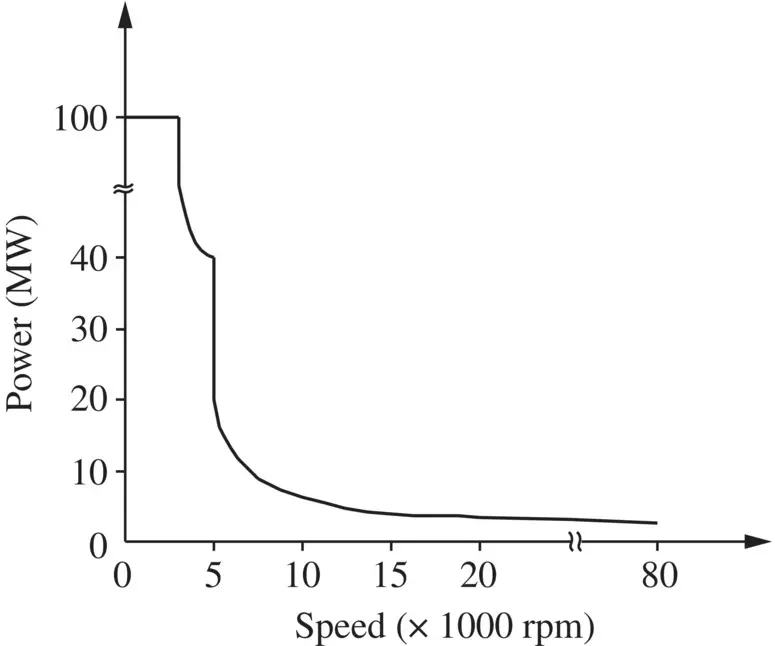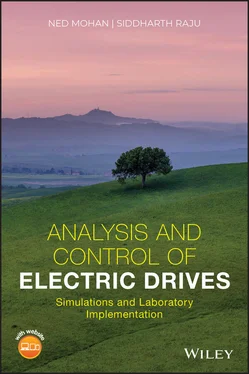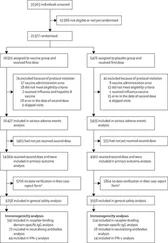
Fig. 1-6 Need for controlling the electromagnetic torque T em.
1‐6 RANGE OF ELECTRIC DRIVES
Electric drives are increasingly being used in most sectors of the economy. Figure 1-7shows that electric drives cover an extremely large range of power and speed – up to 100 MW in power and up to 80 000 rpm in speed.

Fig. 1-7 Power and speed range of electric drives.
Due to the power electronic converter, drives are not limited in speeds, unlike line‐fed motors that are generally limited to 3600 rpm or so with a 60‐Hz supply (3 000 rpm with a 50‐Hz supply).
1‐7 THE MULTIDISCIPLINARY NATURE OF DRIVE SYSTEMS
The block diagram of Fig. 1-1b points to various fields, which are essential to electric drives: electric machine theory, power electronics, analog and digital control theory, real‐time application of digital controllers, mechanical system modeling, and interaction with electric power systems. A brief description of each of the fields is provided in the following subsections.
1 Theory of electric machinesFor achieving the desired motion, it is necessary to control electric motors appropriately. This requires a thorough understanding of the operating principles of various commonly used motors, such as dc, synchronous, induction, and stepper motors. The emphasis in an electric drives course needs to be different from that in traditional electric machines courses, which are oriented toward the design and application of line‐fed machines.
2 Power electronicsIn Fig. 1-1b, voltages and currents from a fixed form (in frequency and magnitude) are converted to the adjustable form best suited to the motor. It is important that the conversion takes place at a high‐energy efficiency, which is realized by operating power semiconductor devices like switches.Today, power electronics is being simplified using “Smart Power” devices, where power semiconductor switches are integrated with their protection and gate‐drive circuits into a single module. Thus, the logic‐level signals (such as those supplied by a digital signal processor) can directly control high‐power switches in the converter. Such power‐integrated modules are available with voltage handling capability approaching 4 kV and current handling capability above 1000 A. Paralleling such modules allows even higher current handling capabilities. The progress in this field has made a dramatic impact on PPUs by reducing their size and weight, while substantially increasing the number of functions that can be performed. Recently, there has been a quiet revolution where transistors based on wide bandgap materials such as SiC and GaN are commercialized. These devices have many superior characteristics compared to original Si‐based devices, thus increasing the efficiency of power converters and reducing the system cost.
3 Control theoryIn the majority of applications, the speed and position of drives need not be controlled precisely. However, there is an increasing number of applications, for example, in robotics for automated factories, where accurate control of torque, speed, and position is essential. Such control is accomplished by feeding back the measured quantities, and by comparing them with their desired values, in order to achieve a fast and accurate control. In most motion control applications, it is sufficient to use a simple proportional‐integral (PI) control, as discussed in this book. The task of designing and analyzing PI‐type controllers is made easy due to the availability of powerful simulation tools.
4 Real‐time control using DSPsAll modern electric drives use microprocessors and digital signal processors (DSPs) for flexibility of control, fault diagnosis, and communication with the host computer and other process computers. The use of 8‐bit microprocessors is being replaced by 16‐bit and even 32‐bit microprocessors. DSPs are used for real‐time control in applications which demand high performance or where a slight gain in the system efficiency more than pays for the additional cost of sophisticated control.
5 Mechanical system modelingSpecifications of electric drives depend on the torque and speed requirements of the mechanical loads. Therefore, it is often necessary to model mechanical loads. Rather than considering the mechanical load and the electric drive as two separate subsystems, it is preferable to consider them together in the design process. This design philosophy is at the heart of Mechatronics.
6 SensorsAs shown in the block diagram of electric drives in Fig. 1-1b, voltage, current, speed, and position measurements may be required. For thermal protection, the temperature needs to be sensed.
7 Interactions of drives with the utility gridUnlike line‐fed electric motors, electric motors in drives are supplied through a power electronic interface (see Fig. 1-1b). Therefore, unless corrective action is taken, electric drives draw currents from the utility that are distorted (non‐sinusoidal) in their wave shape. This distortion in line currents interferes with the utility system, degrading its power quality by distorting the utility voltages. Available technical solutions make the drive interaction with the utility harmonious, even more so than line‐fed motors. The sensitivity of drives to power system disturbances such as sags swells and transient overvoltages should also be considered. Again, solutions are available to reduce or eliminate the effects of these disturbances.
1‐8 USE OF SIMULATION AND HARDWARE PROTOTYPING
Through the course of this book, modeling tools are used to facilitate discussion and provide in‐depth understanding of the concepts in electric drives. MATLAB/Simulink™ and Sciamble™ Workbench [5] are computer simulation tools used to demonstrate all topics in this course.
MATLAB/Simulink™ is widely accepted as the standard tool for electric drives simulation and analysis. The student version of this tool is sufficient for the purposes of this text and is reasonably priced for educational institutions. With an abundance of online training material, it is easy for a new user to become proficient in its use.
Sciamble™ Workbench is a mathematical simulation tool developed at the University of Minnesota for educational purposes. Workbench simulation software is free of cost enabling academic institutions access to advanced tools in education. All examples and key concepts explained in this book are also simulated using Workbench and the results are provided in the accompanying website.
Another noteworthy motivation for using Sciamble™ Workbench is its seamless transition between mathematical simulation and hardware prototyping modes. Hardware prototyping simplifies the development of a real‐time controller enabling rapid laboratory experimentation of concepts taught in this book. Real‐world experimentation enables a more in‐depth and practical understanding of the contents of this book. Sciamble™’s electric drives hardware kit is used for laboratory implementation of all topics in this book.
All the simulation files using both MATLAB/Simulink™ and Sciamble™ Workbench, as well as the manual for laboratory implementation using Workbench, are available on the accompanying website.
1‐9 STRUCTURE OF THE TEXTBOOK
This book is in three parts: Part I describes the fundamental concepts required for the study of ac electric machines and drives, Part II describes the steady‐state analysis of ac machines and drives, and Part III describes the dynamic analysis of ac drives and their vector control through simulations, leading to the hardware implementation of vector control. Throughout this book, the analysis leads to simulations using MATLAB/Simulink™ and Workbench of Sciamble™ ( www.sciamble.com), a University of Minnesota startup. The simulations in Workbench of Sciamble™ seamlessly lead to hardware implementation, as described throughout the book. These are as follows:
Читать дальше














